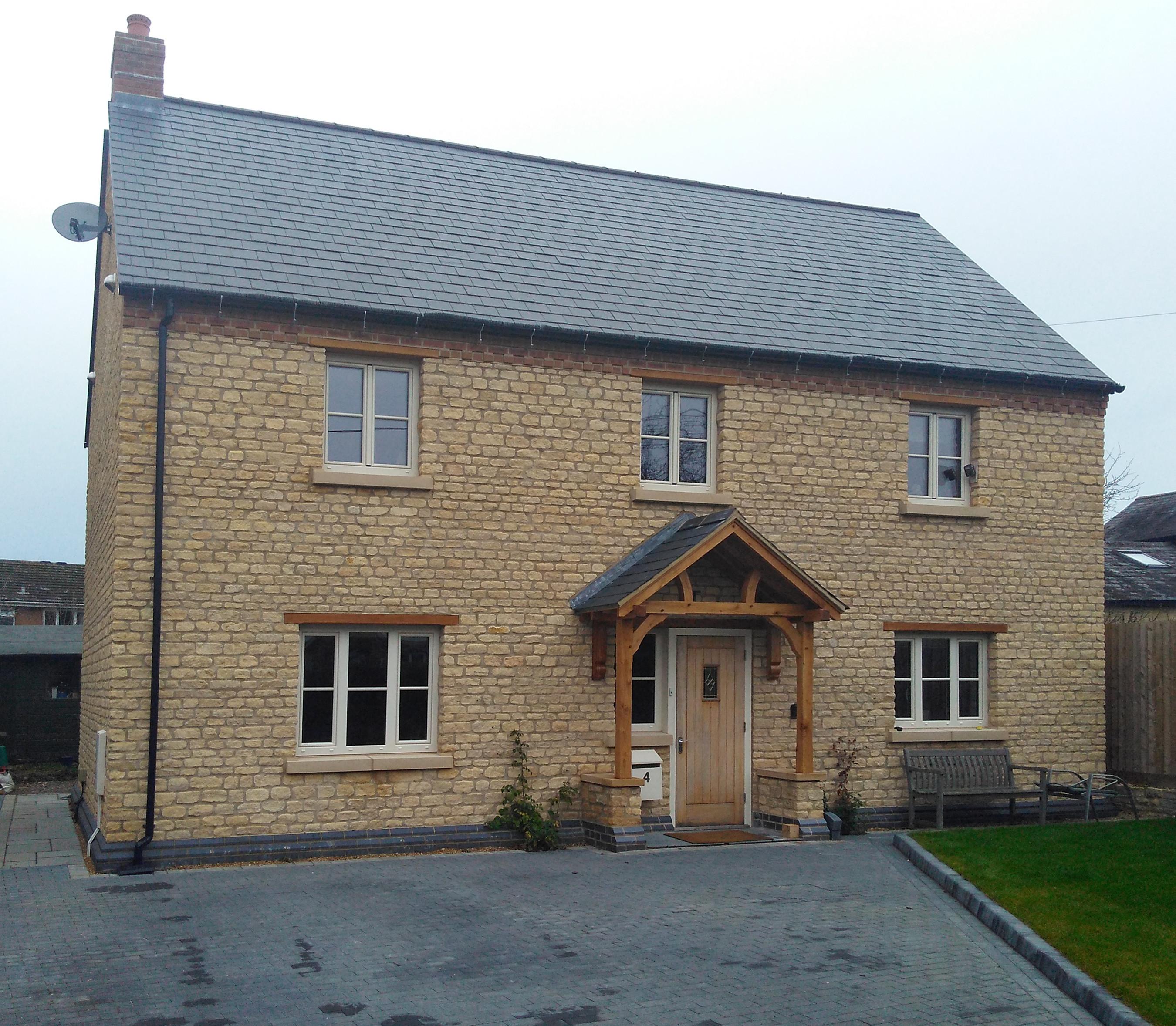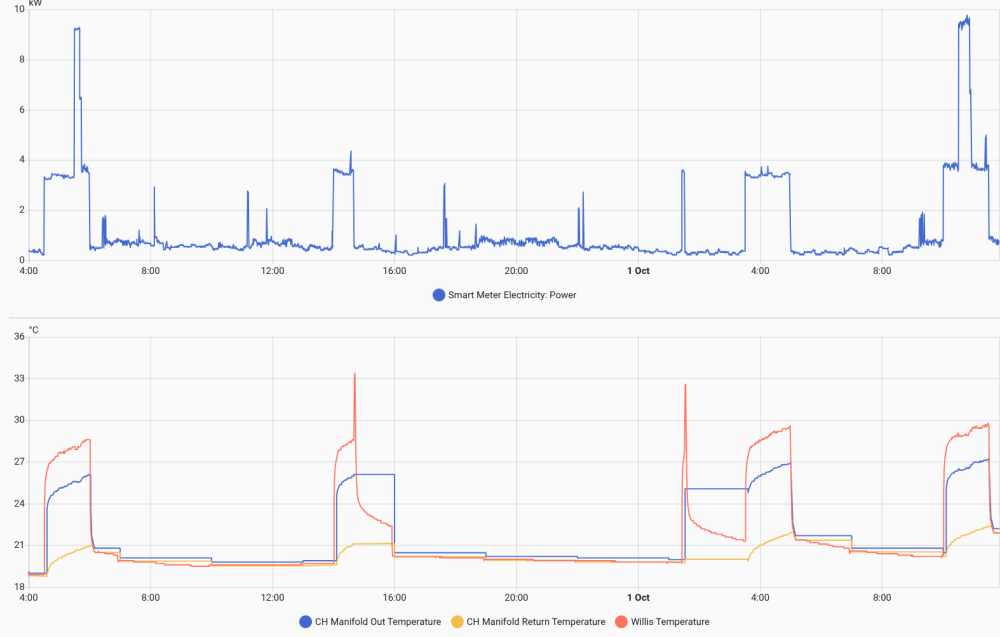
TerryE
Members-
Posts
3764 -
Joined
-
Last visited
-
Days Won
28
TerryE last won the day on November 14
TerryE had the most liked content!
Personal Information
-
Location
Northamptonshire, UK
Recent Profile Visitors
TerryE's Achievements

Advanced Member (5/5)
1.3k
Reputation
-
Grundfos Pump Occasionally Stalls on Willis based UFH system.
TerryE replied to TerryE's topic in Underfloor Heating
@Gus Potter I think that you should optimise any design within sensible engineering tolerances (say a 20% margin in the case of the thermal calcs for a self build, if you have proper review in the design process and QA in be construction). In our case, we split our quite large plot which ran parallel the the street and hence we had enough land to create a separate house plot with its own street access. This adjacency, plus being retired, and that we had previously completely refurbished our old farmhouse on the other half ourselves meant that we had enough knowledge and time to keep a close QA on the build process and to prevent any material off-spec deviations from the as-designed build. The as-lived-in performance of our new house as a system is about 15% lossier than the design and that was down to a single design thermal bridging mistake, which we didn't pick up during review, but did during construction and could therefore largely mitigate. As I said we peak at about 2 kW average heat loss mid winter (when the temperatures outside are below 0). I just can't see the point in having an UFH pipe layout that is capable of delivering 5× that or more. Our 3 loop ground floor UFH keeps our 3 storey house nice and warm, so we have no fixed upstairs CH at all. At some point we might consider an ASHP: I already have the pipework and dedicated 40A spur out to the target pad in place, but just not connected at the house end. We aren't eligible for the BUS and we would only net maybe £400 pa. in running cost savings, so we just can't make an investment case for installing one. A home battery is probably the next item on the wish list ATM. -
Grundfos Pump Occasionally Stalls on Willis based UFH system.
TerryE replied to TerryE's topic in Underfloor Heating
@John Carroll thanks -
The £250 is probably a fare cost of doing an assessment and writing up the report. "Free" means that they need recover the cost factored by win rate, say £1K, on the wins. I think the upfront cost is farer because those that decide to go with Heat Geek don't end up paying for spurious surveys.
-
Grundfos Pump Occasionally Stalls on Willis based UFH system.
TerryE replied to TerryE's topic in Underfloor Heating
Thanks for this, but I made a cock-up and hang my head in shame. I am getting a bit old after all. 🫣😨 I pulled the wrong pump photo from my house pictures. That was a pic of the pump in my old SunAmps which as you say is PCM controlled. My house is 2,000 miles away and I pulled the wrong pic. It's working fine at the mo, so this can wait until I get back on the 12th. I will update then. Sorry guys. PS I think it is a UPS2 25/40-60 130. This has an 240VAC input and H/M/L selector for speed control. 😨 -
Grundfos Pump Occasionally Stalls on Willis based UFH system.
TerryE replied to TerryE's topic in Underfloor Heating
John, I pressured the UVH to 1 bar on commissioning and topped after initial dissolved air bleed off. I haven't needed to top up since. I chose 1-bar because the Pump spec called for a min ½ bar and I could see any advantage in going above 1. The circulation is on the lowest pump setting and this seems to circulate the water fast enough. A good safely check is the willis temp as this rapidly climbs if the pump isn't circulating the water through the slab, and I do have a safety check on this. -
Grundfos Pump Occasionally Stalls on Willis based UFH system.
TerryE replied to TerryE's topic in Underfloor Heating
@Gus Potter, I agree with you in many respects, but also take an opposite view on some. I had just turned 65 when we moved in. Doing a self-build was only feasible for us at this stage in life when we had enough capital and time and effort available to take of some of the trades and jobs ourselves to reduce cost. You mention a 50-60 year objective, but we optimised for about 30 years, as I doubt we'll be around much longer than that. We put a lot of thought into our design and material choices to ensure that the house would be pretty much zero maintenance for that sort of time-frame, but the house should be good for at least another 30-50. If you are talking about a 50 year horizon, then the other key point is that the house has to be electric only -- which it is. The number of UFH loops is just a small design detail that should be matched to the house characteristics. In our case we need to put about 2kW (coldest midwinter) into the slab to keep the entire house at a cosy 22+°C, so 3×95m loops controlled as a single zone works fine for us. The UFH tail length (if long enough) is pretty irrelevant. I feel that your position about automation is about similar to the argument that our predecessors might have had 100 years ago about replacing gas and paraffin heating and lighting by electricity. Technology moves on, so reject it and get stuck in the past or accept and embrace it: this is a personal choice. In my case, our design choices reflect some principles (like all-electric and near zero maintenance), but beyond this they were largely driven by return on investment (RoI) criteria: I have minimised our running costs, and we won't invest in "improvements" unless the discounted savings over a 10-year per period exceed the net investment cost. BTW, I wrote my first computer program 57 years ago and my career was spent in IT so I am very familiar with programming and approaches such as integrated logistic life cycle management. This is why, for example, my CH system is independent of my Home Assistant (HA) stuff; why at a component/module level everything is pretty-standard multi-source commercial off-the-shelf, and i keep enough spares to be able to do cold-swap repair in less that 24 hrs. Putative new buyers could rip out all of the HA system and its IoT devices, but this would leave them a working CH and HW system. They could replace the entire CH / HW control system for under £2K if they stuck with resistive heating, or by then Octopus will probably have a bundled deal to install an ASHP with demand-side managing your CH, HW and EV on some flat-rate tariff. -
Grundfos Pump Occasionally Stalls on Willis based UFH system.
TerryE replied to TerryE's topic in Underfloor Heating
I do VPN into the house routinely to keep an eye on things. I've also got email alerting of any errors like this so I don't miss something on my TODO list. I do cycle the pump for 6 mins every 3 hrs - mainly so that I can log the slab temp, but doing this routinely cycle the UFH and stops any crud selling out in the pipework or pump over the summer. BTW, the Elec Installation sec of the pump manual warns that the pump can have an inrush spike of ~8A at on/off, so advises that any relay should be rated to handle this i.e. have AgSnO contacts (e.g. a contactor) so you might have cycle life issues with the Shelly causing it to fail after a few years. As to spinning these up, it's a two min job and there's even a YouTube howto on this. Next time send the customer a link and say this is a routine home owner job - or charger a hefty call out fee. BTW if you are passing the MK area and need an overnight / nice meal then give me a shout - so long as we are in country that is. 😄 -
Grundfos Pump Occasionally Stalls on Willis based UFH system.
TerryE replied to TerryE's topic in Underfloor Heating
It's a Grundfos UPM2 15-70 CIL2 that runs at about 40W. Easy to bump start manually except that I am in Greece at the moment and my house is over 2,000 miles away in the UK, but back home in just over a week. In the meantime, I've downloaded the manual for this model and will read it. I will also monitor the HA system to see if we get any more stalls. The water is inhibited but there is little scope for electrolytic corrosion: no rads; just the PexAlPex going into the Wunda manifold and a short loop-back through the Willis. The expansion vessel and fill input is T'd off this. I need to give my live-in son some basic plumbing and home automation lessons. 🤣 -
Short version: We have an 8 year old passive-class all-electric house running on and optimised for the Octopus Agile tariff with electrically heated wet UFH. We made the house ASHP ready, but didn't install one during the build, instead using an inline Willis heater as a "temporary" solution to allow us to size the ASHP on actual house performance. In practice the running costs are low enough that we've never made the RoI case to install an ASHP so here we are 8 years later and still using the Willis. One of the major advantages of my design is that it has very few moving parts so pretty much no servicing maintenance is needed: some CU mounted contactors, some commercial ESP based modules, the Willis and the UFH pump. I keep cold-swap spares for the relays, modules and the Willis. But now the pump has occasionally stalled. Is it time to get a cold-swap spare or should I just have done and replace it? @Nickfromwales you are the oracle on such matters. Longer supplementary. My CH control system is a NodeRED based app comprising about 1K lines of JavaScript and some NodeRED flow including maybe 50-100 other NodeRED nodes -- a fairly small app by NodeRED standards. This uses MQTT to talk to the ESP modules and to share data with a Home Assistant instance which I use as a general Home automation interface. My basic strategy is to move any time-shiftable electricity loads to the cheapest Agile tariff time slots: white-goods, EV, HW and CH heating. This is workable because the thermal capacity of the house is so high that it doesn't really matter when I schedule heating so long as I top up enough each day overall. Each day just before tariff roll-over, the system calculates the heating required for the day ahead and allocates a heating schedule so that we do this at the cheapest price. So our typical electricity use is a base ripple of stuff that can't easily be time shifted, plus big blocks of power draw at the cheapest prices that day. See the graph below which is an extract for 32 hours starting 4 AM yesterday. The top plot is our spot energy use taken from our smart meter; the bottom plot is the Willis temp, plus the average out and return flow temps from the UFH loops. The cheapest price slot was 04:30 - 06:00 so that was when the main UFH heating slot was scheduled (the spike to 9kW spike was when the HW immersions also kicked in) ) You can see the typical UFH heating curve: The Willis quickly heats to ~27°C with the average out flow to the UFH a couple of degrees cooler and the return at 19°C (the overall slab temp); these all slowly rise together by about 2½°C over the next 90 mins as the heat transferred warms the slab around the UFH pipe. This pattern happens on four heating cycles during this period. BTW, the out & return flow temperature readings are steppy because these thermometers are only read if the circulation pump has been running for at least 5 mins, because these rapidly settle to the ground-floor ambient temperatures without circulation. The pump is cycled for 6 mins every 3 hours to enable the slab temp to be tracked. Note that some went wrong at 14:41 and the following 01:31. Here the Willis suddenly started heating rapidly until the 35 °C safety trip was exceeded and the CH system turned off the Willis. The system log shows that the pump relay was still on but the water wasn't circulating: it had stalled at 14:41 and was still stalled when it came on again at 01:30. What is odd is that it started correctly at the 3:30 heating slot, so the stall is intermittent . Very odd.
-
BTW the little <> icon in the post form can be used to insert code, e.g. try: dt = parse_ts(s) assert dt.tzinfo is not None and dt.utcoffset().total_seconds() == 0 print("OK ", s, "→", dt.isoformat()) except Exception as e: print("FAIL", s, "→", repr(e)) It also does nice syntax highlighting. You can also use the TR ... icon to edit previous posts and add code formatting 🙂
-
Fabric and ventilation heat loss calculator
TerryE replied to Jeremy Harris's topic in Heat Insulation
@flanagaj IMO this is in the noise. JSH's sheet is an approximate indicator for general sizing. Yes, you could net off the fenestration area, but then again windows etc. typically have ~10× the U-value of decent wall profiles. Also you also get additional edge-effect heat losses where surface meet such as where walls meet and where fenestration meets the surrounding wall. This is roughly of the same order as this netting out, so I wouldn't bother. This simple model is a useful tool but will always be maybe a 20+% under estimate because of this edge effects and bridging losses that always creep into as-built houses.- 170 replies
-
- 1
-

-
- heat loss
- ventilation
-
(and 4 more)
Tagged with:
-
Can't connect the SWA cable. Practical help please.
TerryE replied to saveasteading's topic in Power Circuits
BTW I personally always use crimp terminals on multi-core cables going into screwed connectors, especially if the cable is carrying a sustained high current load. However, these aren't needed for Wago type connectors as the connector maintains good contact if the multi-core deforms under clamping load. -
Can't connect the SWA cable. Practical help please.
TerryE replied to saveasteading's topic in Power Circuits
@saveasteading YouTube is your friend here. There are lots of howto videos; watch a few. One trick that's important is making sure that you cut the SWG sheath neatly and to the right length. You need to mark the snip line and use a decent pair of wire snips that are man enough for the wire gauge. I don't know if its the recommended way but I have an old fashioned adjustable pipe that rated up to 28mm copper. I just cut the outer PVC sleeve with a knife as a guide, then do a dozen + turns to finish cut into the SWG to notch it. Doing it this way keeps the wire well clamped for the nothing I then cut back the outer sheath to the notch ring and then fatigue break the SWG wires around the notch; cut back the outer to size according to the fitting instructions. Slide the other cover and locking ring over the wire before rolling around the centre 4 / 4 core to flare the wire sheath so than the gland can easily slide into it. As I said look at the videos. After a few fitting, this only takes a few mins mad you will end up with neat jobs like @JohnMo's. -
Planning self build, Northern Ireland
TerryE replied to Kevan Marshall's topic in Introduce Yourself
TBH the regulatory framework in the UK has relaxed as well as ASHP prices dropping a lot in the 10 years since we started our build. If I were 10 years younger and starting now I would probably include a ~3-5 kW ASHP for slab heating / cooling only, with the inline Willis for backup. Still no CH for the 1st and in our case 2nd floor and just immersion heated high insulation for DHW; as for both this keeps complexity down and initial costs low. For us now (on Agile tariff and time-of-day optimised heating) we wouldn't get a 10-year RoI case so these don't make sense to me. To consider an upgrade to ASHP for the UFH, we would still need to get the total "project" costs (including making good) for procurement and install to around £4K for this to give us a viable case for doing this -
I remember Jeremy talking about how nearly all ASHPs are actually Aircon enabled internally but this function is disabled in the UK to qualify for MCS grants. IIRC, in his case he had to flip a DIP switch to re-enable. In other cases, there's a buried set up option to re-enable.





